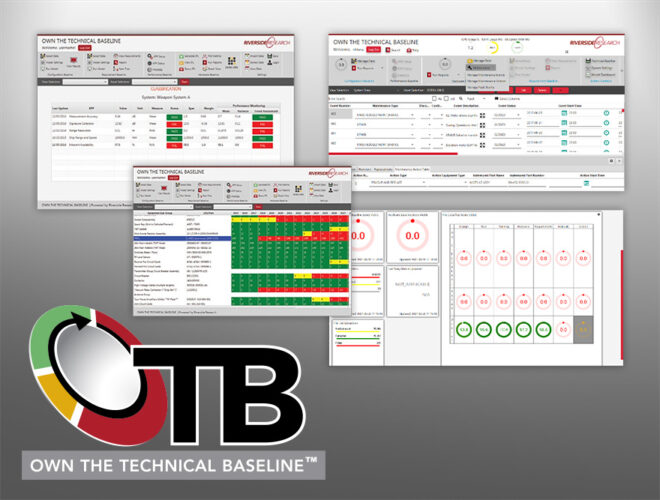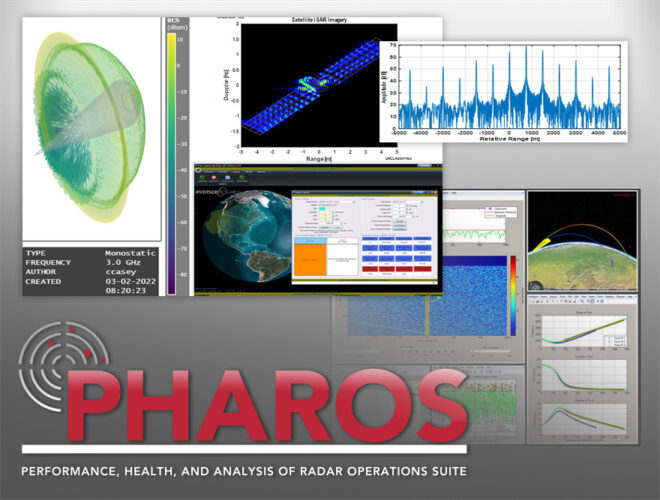
Own the Technical Baseline (OTB)
Own the Technical Baseline™ (OTB) is an analytics tool suite built by Riverside Research to provide full system lifecycle performance monitoring to create a global, dynamic view of predicted sustainment costs and risks. OTB rapidly ingests a variety of system engineering data and artifacts produced throughout the system lifecycle from a variety of vendor-agnostic sources. Once ingested, the tool analyzes the gaps, status of delivery, and health of the configuration baseline. For Reliability, Maintainability, and Availability (RMA) our suite automatically computes predicted component lifespan, evaluates spares availability, and estimates when the system will become degraded or non-operational. Furthermore, OTB conducts performance monitoring of system key performance parameters (KPP) to evaluate trends and anticipate performance issues before they occur. The OTB platform connects all technical baseline data into a single integrated platform available for analysis by the user.
- Open source, commodity platform for simple interfacing with third-party applications
- Easy connection to data with varying standards and databases
- Quickly organize and categorize documents providing gap analysis for configuration baselines
- Up-to-date forecasts for ownership costs and sparing outlooks
- Reduce system engineering review times by utilizing requirement assessment tools
- Perform integrated parts list (IPL) data gap and critical parts analysis
- Predict mission capable status through our KPP performance monitoring tools
- Improve technical baseline analysis through the visualization of relationships of documents, requirements, and parts
- High-fidelity RMA models to the component level

PHAROS
PHAROS stands for Performance Health & Analysis of Radar Operations Suite and it’s a custom radar agnostic tool built by Riverside Research. It runs interactively or as a background process to support all phases of post-mission data analysis. PHAROS will allow radar engineers, data analysts, and system maintainers the ability to conduct rapid, quantitative evaluation of sensor performance and mission success. Our engineers have successfully used PHAROS to identify and investigate any mission anomalies and ultimately recommend solutions. In addition, PHAROS facilitates trend analysis of key performance parameters to identify and avert issues before they lead to degraded operation.
- Assess radar performance
- Evaluate calibration collections to analyze system performance (e.g., metric accuracy, RCS accuracy and sensitivity, range/Doppler resolution and sidelobes, antenna patterns)
- Track system calibration and performance metrics which allows for rapid identification of system degradation
- Conduct system assessment
- Evaluate effectiveness of system algorithms during mission collections
- Integrate numerous single-sensor tools into single tool suite eliminating redundancy
- Object–oriented programming
- Customizable to support multiple sensors
- Extensible to future sensors
RADSim
RADSim is a custom modeling and simulation tool built by Riverside Research to model algorithms and simulate a radar’s functional elements without specialized system/mission hardware or software. RADSim uses a graphical programming language to rapidly build and assess prototypes and perform “what if” trials and algorithm trade studies. Our team has developed a library of radar algorithm modules that users can drag and drop into a model. After an algorithm has been modeled in RADSim, it provides a unique capability to test and evaluate the algorithm’s performance against simulated or live mission data. In addition to generic functional elements, the tool simulates the functional capabilities of the high-fidelity instrumentation sensors.
- Modeling and simulation
- Test and evaluate simulated or live-mission data
RAD|GEN
RadGen is a custom-built synthetic radar data generation toolset designed to capture low-level effects imparted onto the radar signal via target interaction and radar receive chain design. The toolset accepts generic scenario and radar descriptions and generates realistic In-phase and Quadrature (IQ) data representative of the received pulses and characteristic of a given radar system.
- Enable algorithm development and ML approaches to radar data
- Low-level data synthesis to create data for high-level simulators
- Radar System agnostic
- Interference, Jamming, and Electronic Countermeasure (ECM) Modelling
- Clutter, Debris, and Chaff Modelling
- Instrumentation & Imaging quality data
ResourceSIM
ResourceSIM is a low-fidelity radar resource simulator created to simulate a notional or actual radar design’s ability to allocate timeline resources to service multiple simultaneous targets or mission areas from a single sensor. ResourceSIM utilizes a Graphical User Interface to allow users to specify radar search design parameters, select a mission plan, define tracking parameters, select target priorities, and define high-level radar sensor parameters.
- Initial sensor sizing and feasibility studies to assess Courses of Action (COA) and Key Performance Parameters (KPP)
- Compatible with phased-array and dish antennas
- Compatible with pedestal motion constraints and parameters to allow field of view analysis
- Compatible with multiple tracking paradigms to best limit resource expenditure
- Accepts minimalist mission plans and adapts resource scheduling priorities based on these plans
- Provides analyst-ready results and feedback for why tasks were or were not scheduled.
- Command-line interface to create batch jobs to process many variations of sensors, scenarios, and parameters.
Antenna Pattern Toolset
Our Antenna Pattern Toolset is an adaptable, configurable tool able to model electronically steered phased arrays and perform high fidelity antenna analysis. The Antenna Pattern Toolset allows radar engineers the ability to diagnose antenna-related issues and perform stochastic failure analysis on phased arrays. Our tool is scalable - it can represent powerful sensors of 30,000+ elements, allowing us to make data-driven trade studies for current sensor issues or future sensor upgrades. And the toolset is easily customizable to optimize the beam against the threat environment. Plus, it can be integrated with other Riverside Research products (RADSIM, RADGEN, ResourceSIM) for a higher fidelity end-to-end radar simulation.
- Perform system assessment
- Evaluate effects of failure rate analysis (e.g. random array thinning, random phase error distribution, subarray failures, Monte Carlo simulations)
- Analyze different array configurations (e.g., illumination function, array thinning, subarray configuration)
- Object-oriented programming
- Adaptable to any configuration of phased arrays
- Scalable to represent the most powerful sensors
- Experts in Your Competency
